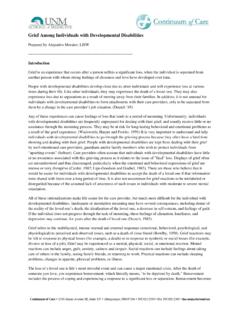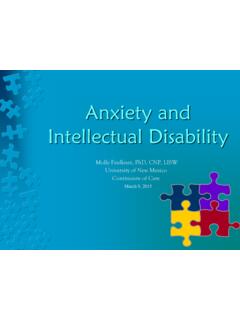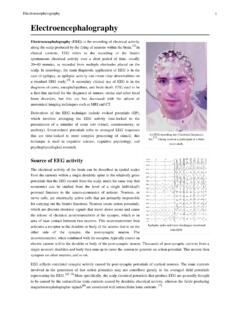Transcription of Indications for Psychotropic Medication Use
1 Indications for Psychotropic Medication Use The following table highlights common diagnostic and clinical Indications for using Psychotropic Medication . This may be used in conjunction with the attached general valid reasons for using Psychotropic Medication as a broad tool for evaluating whether the use seems appropriate. This is not meant to second-guess physicians and their order but as a point of team discussion. When the justification is based more exclusively on signs and Indications , greater care must be taken. For example, more comprehensive baseline data and descriptive information must be documented and regularly reviewed.
2 The identified signs and symptoms must show clear evidence of decreased intensity and severity to justify continued use. The top row identifies the family of Medication with the columns organized in descending order of valid use by Medication family. The table is not meant to be exhaustive, for example the entire family of barbiturate medications is not included as they are rarely used with individuals with developmental disabilities. Neuroleptic (Antipsychotic) Antidepressant Mood Stabilizer Anti-anxiety Stimulant Antiparkinsonian Diagnostic Indications (primary) Psychosis, schizophrenia, schizoaffective disorder, delusional disorder, atypical psychosis Depressive disorders Bipolar mood disorder, depression, schizo-affective disorder Anxiety disorders, (Obsessive compulsive, post- traumatic stress, panic, generalized) Attention deficit disorder Extrapyramidal side effects (secondary)
3 Bipolar mood disorder--acute manic phase, delusional depression Anxiety disorders, (Obsessive compulsive, post- traumatic stress, panic, generalized) Disorders of attention Mood instability Phobic disorders, akathesia, tardive dyskinesia Depressive disorders in those who are medically fragile, narcolepsy Signs and Indications Disorganized thought, poor impulse control Bulimia, narcotic craving and withdrawal depression, chronic pain, poor impulse control Poor impulse control, neuroleptic or antidepressant boost Anxiety symptoms: aggression, sleep disturbance, nightmares, preoccupations Disturbed sleep Six valid reasons for using Psychotropic medications Reason Number 1 To treat a clearly diagnosed primary psychiatric illness: Whether a potential recipient has a developmental disability or not, the criteria established in the Diagnostic and Statistics Manual of Mental Disorders-IV-TR (DSM-IV-TR) or the International Classifications of Diseases-10 (ICD-10), should be satisfied.
4 At least the same depth and breadth of evaluation must be exercised. This becomes increasingly more difficult with more significant developmental disabilities and problems with speech, motor performance, cognitive ability and sensory integration interfere with standardized testing and mental status exams. We expect this problem to diminish as the Diagnostic Manual-Intellectual Disability (DM-ID) becomes more widely and effectively used. Reason Number 2 Medical conditions: Some conditions may have associated secondary psychiatric features. Examples include specific types of epilepsy , which may lead to a variety of seizures and problematic behaviors.
5 For example, temporal lobe seizures can appear as unusual behaviors. Use of appropriate Psychotropic Medication for this reason should continue until the primary condition is treated and the symptoms resolve, or until it is clear that, even with treatment, the psychiatric symptoms will continue. Long term Medication therapy will frequently be necessary in order to control symptoms. Examples of other medically indicated uses are small doses of antipsychotic drugs prior to chemotherapy (for the antiemetic effect) or general anesthesia . Reason Number 3 Emotionally distressing, extreme behavior that interferes with important aspects of a person s life: This is perhaps the most contentious and challenging rationale.
6 The risk of it being used as a garbage can to justify Medication for a variety of unpleasant, obnoxious, even hurtful behaviors that serve clear functional means for an individual is inherent. This rationale should be accompanied by a comprehensive assessment of the behavior that includes a functional assessment. If such assessment is unavailable or yields unclear results and intermediate intervention is necessary for safety or continued inclusion in support efforts short term Psychotropic intervention may be considered. Use of Medication in these circumstances is most clearly indicated when the individual with developmental disabilities who presents challenging behavior expresses a desire for the behavior to be controlled.
7 When the person cannot clearly communicate intentions, discerning the appropriateness of Medication is more complicated. Reason Number 4 For empirical reasons, to address severe dysfunction that has been resistant to other intervention: There are times when the use of Psychotropic Medication should be considered when addressing a chronic condition or characteristic (other than behavior) which significantly interferes with an individual s social functioning and quality of life, particularly when exhaustive habilitative, environmental and lifestyle adaptation interventions have not provided relief. If effective, the smallest dose should be sought, with occasional, systematic attempts to reduce or discontinue the Medication .
8 An example is using a mild anxiolytic to ease acute difficulty with transitions experienced by an individual diagnosed with Pervasive Developmental Disorder (PDD), even when an anxiety disorder diagnosis is not established. Reason Number 5 To treat Medication withdrawal or discontinuation symptoms: There is a growing awareness that people may experience withdrawal difficulties from a variety of Psychotropic medications, although they may be markedly softened with gradual reductions. These symptoms may include anxiety, agitation, unstable mood, self-stimulation, insomnia, expressiveness, sexual expression, property destruction, and self-injury.
9 Another instance would be when upon decreasing or discontinuing a Psychotropic Medication which masked severe tardive dyskinesia symptoms a return to a small dose or alternative drug may be required. For a small group of individuals with developmental disabilities who exhibit chronic, severe self-injury, withdrawal from endogenous endorphins may be a factor needing Psychotropic Medication intervention. Endogenous endorphins are naturally occurring neurotransmitters which have a narcotic-like effect. For some, withdrawal from alcohol, caffeine, nicotine or illicit drugs may require short term intervention.
10 Reason Number 6 For sedation during a medical procedure: When the importance of a medical procedure is unquestioned and the procedure cannot be performed without sedation, a Psychotropic may be used for its sedating effect. For some individuals these medical procedures may include dental work, diagnostic evaluations such as EEGs, EKGs, C-T scans or physical exams. If used for this purpose, an adequate dose to accomplish the desired sedation must be sought and balanced against the least potential side effects. Cautions and Questionable Uses of Psychotropic Medication Just as there are clear reasons to consider the use of Psychotropic medications, there are also questionable ones, many of which suggest misuse of the drug and, potentially, abuse of the individual with developmental disabilities.









![How to Interpret and EEG and Its report.ppt [Read-Only]](/cache/preview/9/a/8/4/5/3/5/0/thumb-9a84535099038c890ee91bcb8802c130.jpg)




